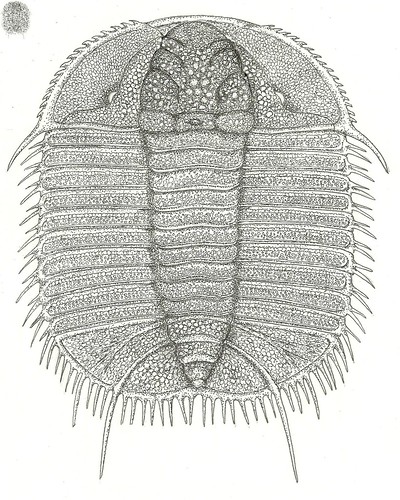Following the fossil theme, this is the reconstruction I did for another paper that's just come out (Conway & Botting, in Geological Magazine) . It's an odontopleurid trilobite from the Middle Ordovician of Llandrindod that Tim worked on for his MSci project, and a spectacularly spiky beastie it is too.
Why all those spines? Don't really know. The odontopleurids as a whole are characterised by very spiny outlines, but this one has more than most. What the function was, we're not clear on - it may be as simple as camouflage - it breaks up the outline on the sea floor, especially with all those tubercles on the surface. It may have made them less easy to eat, but you'd think that would only affect things that swallowed them whole. One curious fact that Tim uncovered is that in the genus Meadowtownella, the number of spines around the tail decreases with time (this one is the oldest yet described). However, it also occupied muddy areas rather than reef areas, which is bound to have had an effect. Jury's out on that one.
Another curiosity: this has never been found, even the tiniest fragment of it, anywhere except for one site. At that site, it's abundant - Tim collected hundreds of fragments - through about 60 m of mudstone. That's a long time - in the history of a volcanic island, it's a very long time. What was it about that small area that allowed it to thrive, when elsewhere it didn't seem to exist at all? Is it just that it lived for a very short time, and this was the only place in the area where exactly the right age was exposed? Or was it to do with the oxygenation levels at the sea floor, or the need for a particular food source, which lived in that area..?
I'm getting an interesting perspective from all the time spent looking at modern bugs. The Cornish Shieldbug, for example, is restricted in the UK to one cove; there are historical records for another site in South Wales, but not for a very long time. The bug lives on sand dunes, and is associated with a common host plant (Galium verum). It can also fly. Why hasn't it got anywhere else? It's thriving at its home, but doesn't seem able to expand. There is presumably something specific in the habitat that we're not quite understanding, and it's not by any means the only example of this, even among UK bugs.
How much harder is it to work out for the fossil record? We don't even know the habitat preferences of many species, and for some entire groups, such as planktonic graptolites, we don't even have anything modern to compare them with. We do know that some trilobites were quite widespread - Ogyginus corndensis, for example, turns up in a wide variety of environments. Others, like Meadowtownella were much more restricted. Many species were simply very, very rare - only one specimen of several species of trilobites have ever been found in the Builth Inlier - so what we know about those can be written on the back of an odontopleurid.
This to me is where palaeontology gets really interesting... it's not just finding the things that matters, but really understanding them. Interpreting the ancient past when you only have a few scraps of information to go on is a challenge, certainly, but it's also a wonderful journey of discovery...
reference: http://www.rairo-ita.org/action/displayAbstract?fromPage=online&aid=8351175
Sunday, 28 August 2011
Meadowtownella serrata
Subscribe to:
Post Comments (Atom)


No comments:
Post a Comment